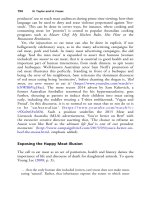The palgrave international handbook of a 209
Bạn đang xem bản rút gọn của tài liệu. Xem và tải ngay bản đầy đủ của tài liệu tại đây (27.24 KB, 1 trang )
204
A. Nurse
other less powerful members of a family or a community. Calvo (2008,
pp. 32–33) identifies that human–animal relations are dominated by ‘relations of human dominion that involve their exploitation and oppression’.
Thus animal lives are largely subservient to human conceptions of animals as
potential food or as exploitable resource for clothing, labour or entertainment
(see the chapters on this in this volume). The cruelty inflicted on animals,
whether physical or psychological, often illustrates stereotypical male behaviour such as the exercise of control through physical force, intimidation and
coercion employed in other areas such as domestic abuse, spousal control or
the disciplining of children (Arkow 1996; Browne 1993). Many animal
crimes (such as trophy hunting and illegal taking of wildlife) also involve
recognised male behaviours such as aggression, thrill-seeking or the exercise of
an adventurous nature (Nurse 2011). Recklessness, thrill-seeking and assertiveness are also applicable to animal abuse activities which are sometimes
committed in difficult and dangerous conditions, with a requirement to
negotiate aggressive animals, and evade the attentions of law enforcement,
NGOs and conservation and game management staff. Sport and trophy
hunting linked to the collection of animal trophies, such as antlers, tusks
and skins, is inextricably linked to power and masculinities within a deviant
recreational culture. Such hunting enthusiasts are predominantly male and
tend to target larger nonhuman animal males for shooting (Palazy et al. 2012;
Short and Balaban 1994) thus overtly exercising masculine power over less
powerful males; those animals selected for hunting purposes.
This chapter examines collecting as a form of animal abuse, examining
the collection of both live and dead non-human animal specimens, and
non-human animal parts and derivatives as forms of animal abuse. Some
collecting activities are difficult to quantify due to their covert nature and
the lack of any official monitoring. Egg collecting, for example, is an
underground activity that encompasses a range of unlawful activities in
the taking and possession of eggs (see Case Study 1 later in this chapter).
But no formal market exists for wild birds’ eggs (Nurse 2013a) and its
basis in collecting for personal possession contributes to the difficulties in
assessing its prevalence although Table 1 identifies recent reported levels
of offending in the UK. However, activities like trophy hunting form
part of a legitimised industry worth considerable sums to some African
countries (Lindsey et al. 2012; Palazy et al. 2012; Baker 1997). Thus,
collecting linked to sporting activity is widespread in some states and is
discussed later in this chapter (see Case Study 2). Anthropocentric
notions of animals as human ‘property’ and available primarily for
human exploitation, are central to animal collecting. Unhealthy or









